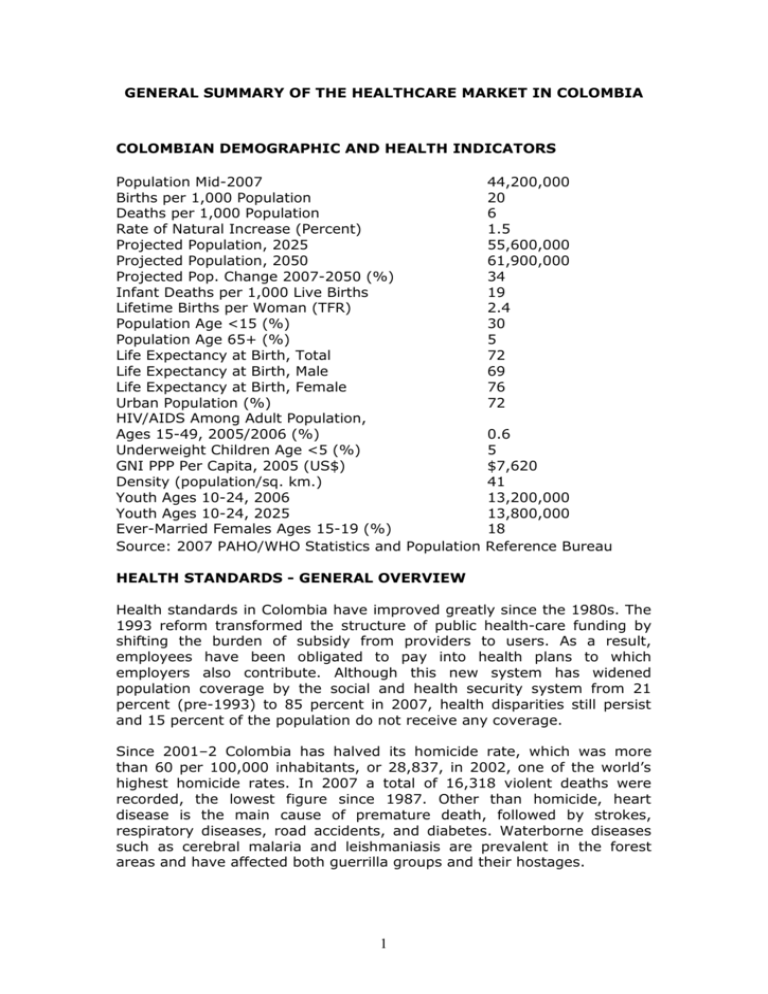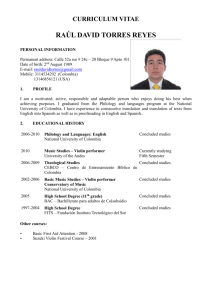general summary of the healthcare market in colombia
advertisement

GENERAL SUMMARY OF THE HEALTHCARE MARKET IN COLOMBIA COLOMBIAN DEMOGRAPHIC AND HEALTH INDICATORS Population Mid-2007 Births per 1,000 Population Deaths per 1,000 Population Rate of Natural Increase (Percent) Projected Population, 2025 Projected Population, 2050 Projected Pop. Change 2007-2050 (%) Infant Deaths per 1,000 Live Births Lifetime Births per Woman (TFR) Population Age <15 (%) Population Age 65+ (%) Life Expectancy at Birth, Total Life Expectancy at Birth, Male Life Expectancy at Birth, Female Urban Population (%) HIV/AIDS Among Adult Population, Ages 15-49, 2005/2006 (%) Underweight Children Age <5 (%) GNI PPP Per Capita, 2005 (US$) Density (population/sq. km.) Youth Ages 10-24, 2006 Youth Ages 10-24, 2025 Ever-Married Females Ages 15-19 (%) Source: 2007 PAHO/WHO Statistics and Population 44,200,000 20 6 1.5 55,600,000 61,900,000 34 19 2.4 30 5 72 69 76 72 0.6 5 $7,620 41 13,200,000 13,800,000 18 Reference Bureau HEALTH STANDARDS - GENERAL OVERVIEW Health standards in Colombia have improved greatly since the 1980s. The 1993 reform transformed the structure of public health-care funding by shifting the burden of subsidy from providers to users. As a result, employees have been obligated to pay into health plans to which employers also contribute. Although this new system has widened population coverage by the social and health security system from 21 percent (pre-1993) to 85 percent in 2007, health disparities still persist and 15 percent of the population do not receive any coverage. Since 2001–2 Colombia has halved its homicide rate, which was more than 60 per 100,000 inhabitants, or 28,837, in 2002, one of the world’s highest homicide rates. In 2007 a total of 16,318 violent deaths were recorded, the lowest figure since 1987. Other than homicide, heart disease is the main cause of premature death, followed by strokes, respiratory diseases, road accidents, and diabetes. Waterborne diseases such as cerebral malaria and leishmaniasis are prevalent in the forest areas and have affected both guerrilla groups and their hostages. 1 Acquired immune deficiency syndrome (AIDS) is the fifth-leading cause of death in the working-age population. According to Colombia’s National Health Institute data reported in 2005, nearly 240,000 people—mostly women and young people—or 0.6 percent of the population had been infected with the virus since AIDS arrived in Colombia in October 1983. Estimates of the number of people living with human immunodeficiency virus (HIV), adults and children (0–49 years of age), in 2005 ranged from 160,000 to 310,000. The comparable figure for women (15–49 years of age) was 62,000. The number of AIDS and hepatitis B cases has been rising. In 2005 the estimated HIV adult prevalence rate (15–49 years of age) was 0.6 percent. As of 2006, between 5,200 and 12,000 people had died from AIDS. Services provided by the new Multisectoral National Plan, launched in July 2004, include integrated care for people living with HIV and provision of antiretroviral drugs. Under the plan, about 12,000 people have been receiving combined antiretroviral therapy (approximately 54 percent of those requiring it). STRUCTURE OF THE HEALTH SECTOR In the eighties and early nineties, the nation’s healthcare system was a state-run-monopoly. Employers and employees paid into a pool and the money was used to fund the government-sponsored social security system. While wealthier people took advantage of elite healthcare services in private clinics, the vast majority of people had no option but to use the state-run social security system (The Social Security Institute – ISS). Everyone else had to rely on charity and public institutions. The 1993 reform transformed the structure of public health-care funding by introducing the contributory and subsidised regime. As a result, levels of coverage have shown steady increases from 25% in 1993 to 47% in 1996 and 62% in 2002. THE CONTRIBUTORY REGIME As of 2007, 17.1 million or 38% of Colombia’s total population were part of the nation’s contributory regime. This includes: private sector employees; public servants; pensioners; and independent workers with financial resources to make payments (with income of at least one minimum wage – about US$220), along with their beneficiaries (legally married spouses/partners after 2 years of living together and children. In the case of single people, the parents are entitled to this coverage). Currently set at 12.5% of each monthly salary, both employee and employer must contribute with 4% and 8.5%, respectively. Each year, the percentage is set and increased by law. The people on this regime buy their care from a Health Promotion Entity EPS (at present approx. 35 exist) of their choice. In turn, the EPS contracts medical cover with a Health Provider Institution – IPS. 2 EPSs can be public or private and they contract with the Healthcare Provider Institutions (IPSs) the provision of healthcare services. All hospitals, doctors’ offices, laboratories, primary care centres and any other healthcare centres as well as all health professionals who jointly or individual provide their services through the EPSs, are considered IPSs. Today, there are approximately 12,000 IPSs registered in Colombia and 20,000 not registered. The Subsidised Regime The Subsidised Regime will include independent workers with monthly incomes below one minimum wage (and their family group) and all individuals with no payment capabilities, whose affiliation is made through the total or partial payment of the per capita payment unit (CPU), financed mainly through tax revenue resources. In 2007, 21.6 million people were under the Subsidised Regime (47% coverage of the total population). The government has the aim to cover as much as 24.8 million people in 2010. About 800,000 people buy complementary plans from non-EPS health insurance companies called Pre-paid Healthcare Companies (Empresas de Medicina Prepagada-EMPs). The purpose of these plans is to increase the quality of the hospital care in leading private entities. At present approximately 12 EMPs exist. Uncovered Population There is still a high number of Colombians that do not have access to any type of coverage, 15% of total population or 6 million. These people usually live in the rural areas or in the most deprived sectors of the cities. However, the government has indicated its goal to reduce the number of those not covered by the system to only 6% by 2010. There has been a recent study (August 2008) on the national provision of health services (not published yet), carried out by the University of Antioquia, the National Prosecutors Office, the Industrial University of Santander and Colciencias. Said study included interviews to 179 experts (doctors, nurses, community leaders, IPS and EPS administrators and 96 public and private institutions), which mainly outlines the following findings: - The Government’s main concern is to increase population’s health coverage, but there is not guarantee for the quality on the provision of the services or the effective access to the services. It is indicated that in spite of a person being affiliated to the system there is not guarantee that there will be real access to the services. - The EPS and other service providers are mainly driven by economic considerations to the extent that they deny the provision of services to some users. 3 Access to Medications The General Social Security and Health System guarantees access to generic essential drugs (from a list of some 350 medicines) through the Mandatory Health Plan (POS) for those insured under the contributory regime, with certain restrictions for those under the subsidised regime. For those not covered by the system, there is almost no access to any medications at all, since this is strictly limited to primary care medications that do not exceed a value of Col$ 8,000 (US$4). Medical Statistics There are well in excess of 899 public hospitals/medical centres and 4,458 health institutions in Colombia and 53 medical schools. Of these schools, 38 are private and 15 are public. (27 are members of ASCOFAME (Colombian Association of Faculties of Medicine: 12 public and 15 private.) It is worth noting that 15 medical schools have their own hospitals whilst the other schools must make agreements with local hospitals to receive practical teaching (including care). At present, these agreements are causing considerable problems to hospitals. There are some 63,000 doctors in Colombia (10.36 per 10,000 inhabitants, as compared with a worldwide proportion of 25.64), of whom 43,000 are “general doctors” and 20,000 are specialists. The doctors are concentrated in the urban areas and the more affluent parts of the country. 23,950 nurses, and 33,951 dentists; these numbers equated to 1.35 physicians, 0.55 nurses, and 0.78 dentists per 1,000 population, respectively. In 2005 Colombia was reported to have only 1.1 physicians per 1,000 population, as compared with a Latin American average of 1.5. Misallocation of funds and evasion of health-fund contributions considerably affect the health sector. General government spending on health accounted for 18% of total government expenditures and for 85 percent of total health expenditures (private expenditures made up the balance) in 2007. Total expenditures on health were 7.8% of gross domestic product or US$ 13.4 bio. in 2007, where 4.7% corresponds to the private sector and 3.1% to the public sector. This amount is considerably higher than that allocated by other countries in the region such as Ecuador (4.8%); Venezuela (5.4%); Chile (5.9%) and Mexico (5.7%). As a consequence of the health system reform of 1993, there have been some noteworthy advances in the area of biomedical technology. These are: (1) (2) The provision of maintenance services in public sector health institutions has been regulated. There is a detailed inventory of infrastructure resources in secondand third-level hospitals (170 institutions). 4 The procurement of medical equipment has increased in both the public and the private sectors. UKTI Section British Embassy Bogota April 2009 5





